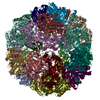+Search query
-Structure paper
| Title | Cryo-electron structures of the extreme thermostable enzymes Sulfur Oxygenase Reductase and Lumazine Synthase. |
|---|---|
| Journal, issue, pages | PLoS One, Vol. 17, Issue 10, Page e0275487, Year 2022 |
| Publish date | Oct 3, 2022 |
 Authors Authors | Mohamed A Sobhy / Lingyun Zhao / Dalaver Anjum / Ali Behzad / Masateru Takahashi / Muhammad Tehseen / Alfredo De Biasio / Rachid Sougrat / Samir Hamdan /  |
| PubMed Abstract | Thermostable enzymes have the potential for use in a wide variety of biotechnological applications. Cryo-electron microscopy (cryo-EM) enables the imaging of biomolecules in their native aqueous ...Thermostable enzymes have the potential for use in a wide variety of biotechnological applications. Cryo-electron microscopy (cryo-EM) enables the imaging of biomolecules in their native aqueous environment. Here, we present high resolution cryo-EM structures of two thermostable enzymes that exhibit multimeric cage-like structures arranged into two different point-group symmetries. First, we determined the structure of the Sulfur Oxygenase Reductase (SOR) enzyme that catalyzes both the oxygenation and disproportionation of elemental sulfur in Archea and is composed of 24 homomeric units each of MW ≃ 35 kDa arranged in octahedral symmetry. The structure of SOR from Acidianus ambivalens (7X9W) was determined at 2.78 Å resolution. The active site of each subunit inside the central nanocompartment is composed of Fe3+ coordinated to two water molecules and the three amino acids (H86, H90 and E114). Second, we determined the structure of Lumazine Synthase (LS) from Aquifex aeolicus (7X7M) at 2.33 Å resolution. LS forms a cage-like structure consisting of 60 identical subunits each of MW ≃ 15 kDa arranged in a strict icosahedral symmetry. The LS subunits are interconnected by ion-pair network. Due to their thermostability and relatively easy purification scheme, both SOR and LS can serve as a model for the catalytic and structural characterization of biocatalysts as well as a benchmark for cryo-EM sample preparation, optimization of the acquisition parameters and 3D reconstruction. |
 External links External links |  PLoS One / PLoS One /  PubMed:36191023 / PubMed:36191023 /  PubMed Central PubMed Central |
| Methods | EM (single particle) |
| Resolution | 2.33 - 2.78 Å |
| Structure data | EMDB-33041, PDB-7x7m: EMDB-33084, PDB-7x9w: |
| Chemicals |  ChemComp-FE:  ChemComp-HOH: |
| Source |
|
 Keywords Keywords | TRANSFERASE / Thermostable Transferase / OXIDOREDUCTASE / Thermostable Oxidoreductase |
 Movie
Movie Controller
Controller Structure viewers
Structure viewers About Yorodumi Papers
About Yorodumi Papers








 Aquifex aeolicus (bacteria)
Aquifex aeolicus (bacteria) acidianus ambivalens (archaea)
acidianus ambivalens (archaea)